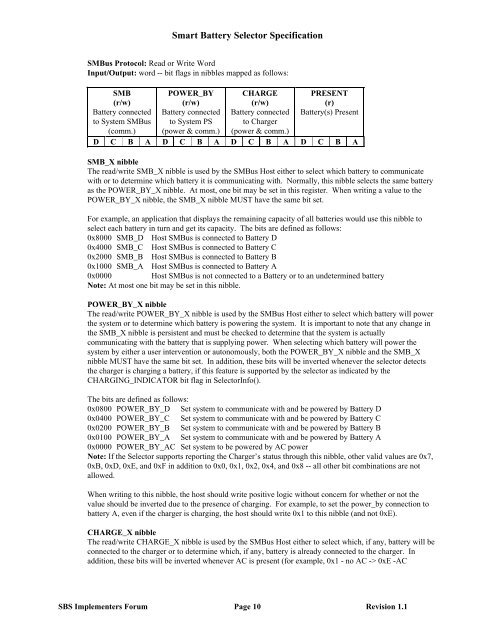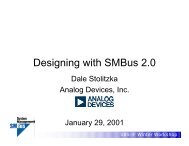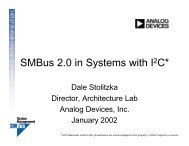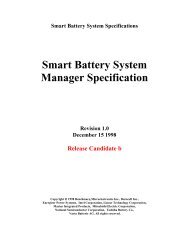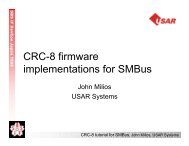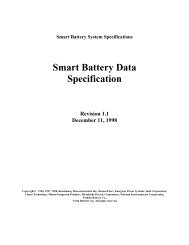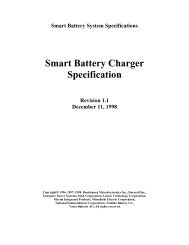Smart Battery Selector Specification Revision 1.1 - SBS-IF Smart ...
Smart Battery Selector Specification Revision 1.1 - SBS-IF Smart ...
Smart Battery Selector Specification Revision 1.1 - SBS-IF Smart ...
You also want an ePaper? Increase the reach of your titles
YUMPU automatically turns print PDFs into web optimized ePapers that Google loves.
<strong>Smart</strong> <strong>Battery</strong> <strong>Selector</strong> <strong>Specification</strong>SMBus Protocol: Read or Write WordInput/Output: word -- bit flags in nibbles mapped as follows:SMB(r/w)<strong>Battery</strong> connectedto System SMBus(comm.)POWER_BY(r/w)<strong>Battery</strong> connectedto System PS(power & comm.)CHARGE(r/w)<strong>Battery</strong> connectedto Charger(power & comm.)PRESENT(r)<strong>Battery</strong>(s) PresentD C B A D C B A D C B A D C B ASMB_X nibbleThe read/write SMB_X nibble is used by the SMBus Host either to select which battery to communicatewith or to determine which battery it is communicating with. Normally, this nibble selects the same batteryas the POWER_BY_X nibble. At most, one bit may be set in this register. When writing a value to thePOWER_BY_X nibble, the SMB_X nibble MUST have the same bit set.For example, an application that displays the remaining capacity of all batteries would use this nibble toselect each battery in turn and get its capacity. The bits are defined as follows:0x8000 SMB_D Host SMBus is connected to <strong>Battery</strong> D0x4000 SMB_C Host SMBus is connected to <strong>Battery</strong> C0x2000 SMB_B Host SMBus is connected to <strong>Battery</strong> B0x1000 SMB_A Host SMBus is connected to <strong>Battery</strong> A0x0000 Host SMBus is not connected to a <strong>Battery</strong> or to an undetermined batteryNote: At most one bit may be set in this nibble.POWER_BY_X nibbleThe read/write POWER_BY_X nibble is used by the SMBus Host either to select which battery will powerthe system or to determine which battery is powering the system. It is important to note that any change inthe SMB_X nibble is persistent and must be checked to determine that the system is actuallycommunicating with the battery that is supplying power. When selecting which battery will power thesystem by either a user intervention or autonomously, both the POWER_BY_X nibble and the SMB_Xnibble MUST have the same bit set. In addition, these bits will be inverted whenever the selector detectsthe charger is charging a battery, if this feature is supported by the selector as indicated by theCHARGING_INDICATOR bit flag in <strong>Selector</strong>Info().The bits are defined as follows:0x0800 POWER_BY_D Set system to communicate with and be powered by <strong>Battery</strong> D0x0400 POWER_BY_C Set system to communicate with and be powered by <strong>Battery</strong> C0x0200 POWER_BY_B Set system to communicate with and be powered by <strong>Battery</strong> B0x0100 POWER_BY_A Set system to communicate with and be powered by <strong>Battery</strong> A0x0000 POWER_BY_AC Set system to be powered by AC powerNote: If the <strong>Selector</strong> supports reporting the Charger’s status through this nibble, other valid values are 0x7,0xB, 0xD, 0xE, and 0xF in addition to 0x0, 0x1, 0x2, 0x4, and 0x8 -- all other bit combinations are notallowed.When writing to this nibble, the host should write positive logic without concern for whether or not thevalue should be inverted due to the presence of charging. For example, to set the power_by connection tobattery A, even if the charger is charging, the host should write 0x1 to this nibble (and not 0xE).CHARGE_X nibbleThe read/write CHARGE_X nibble is used by the SMBus Host either to select which, if any, battery will beconnected to the charger or to determine which, if any, battery is already connected to the charger. Inaddition, these bits will be inverted whenever AC is present (for example, 0x1 - no AC -> 0xE -AC<strong>SBS</strong> Implementers Forum Page 10<strong>Revision</strong> <strong>1.1</strong>


